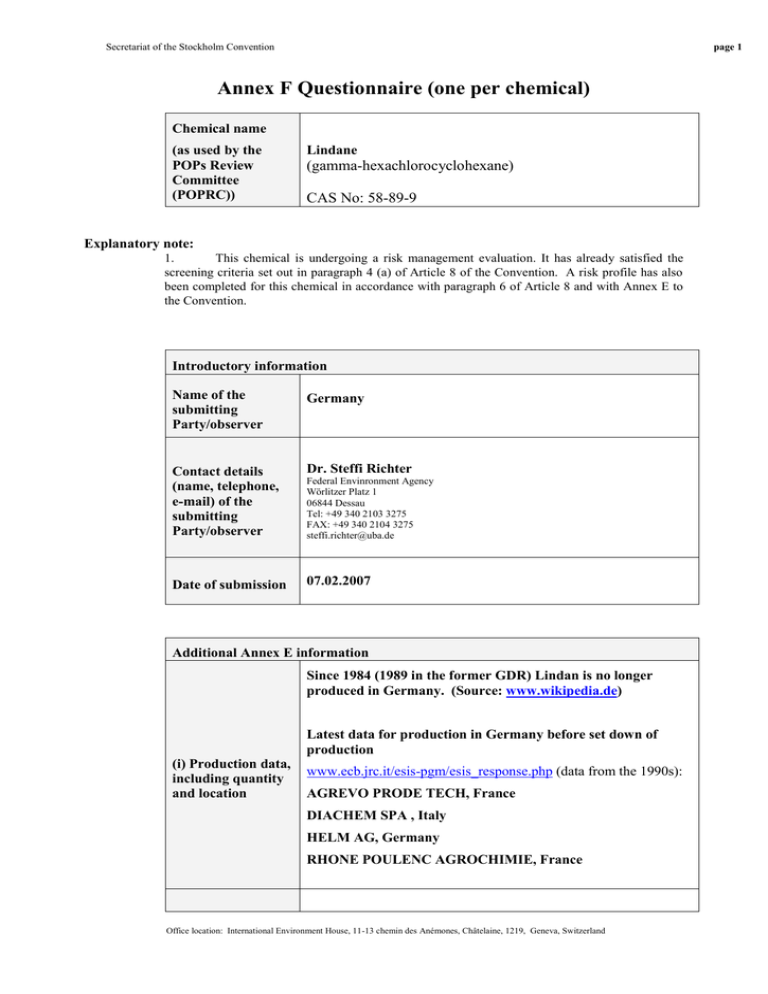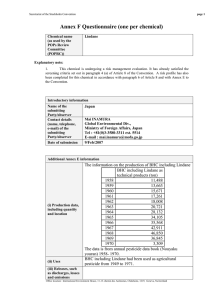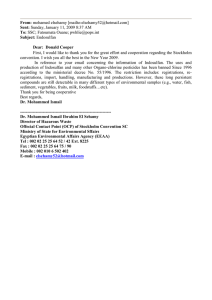Annex F Questionnaire (one per chemical) (gamma-hexachlorocyclohexane) CAS No: 58-89-9
advertisement

Secretariat of the Stockholm Convention page 1 Annex F Questionnaire (one per chemical) Chemical name (as used by the POPs Review Committee (POPRC)) Lindane (gamma-hexachlorocyclohexane) CAS No: 58-89-9 Explanatory note: 1. This chemical is undergoing a risk management evaluation. It has already satisfied the screening criteria set out in paragraph 4 (a) of Article 8 of the Convention. A risk profile has also been completed for this chemical in accordance with paragraph 6 of Article 8 and with Annex E to the Convention. Introductory information Name of the submitting Party/observer Germany Contact details (name, telephone, e-mail) of the submitting Party/observer Dr. Steffi Richter Date of submission 07.02.2007 Federal Envinronment Agency Wörlitzer Platz 1 06844 Dessau Tel: +49 340 2103 3275 FAX: +49 340 2104 3275 steffi.richter@uba.de Additional Annex E information Since 1984 (1989 in the former GDR) Lindan is no longer produced in Germany. (Source: www.wikipedia.de) Latest data for production in Germany before set down of production (i) Production data, including quantity and location www.ecb.jrc.it/esis-pgm/esis_response.php (data from the 1990s): AGREVO PRODE TECH, France DIACHEM SPA , Italy HELM AG, Germany RHONE POULENC AGROCHIMIE, France Office location: International Environment House, 11-13 chemin des Anémones, Châtelaine, 1219, Geneva, Switzerland Secretariat of the Stockholm Convention (ii) Uses page 2 Lindan has been used as insectizide in agriculture and forestry – mainly as wood preservative (e.g. in West-Germany the wood preservative Xylamon BV (in combination with PCP)) . aside, there is a use as a ca. 1% solution in medicine for external use against skin parasites – mainly to treat scabies and lice (pediculoses). Lindan has to be phased-out as an insectizide in Europe by the end of 2007 (regulation 850/2004/EC). (source: www.wikipedia.de) As an insectizide, lindane was used in Germany against Atomaria linearis (German: Moosknopfkäfer) in cultures of sugar or fodder beet, against Elateridae (German: Drahtwurm) in cultures of maize, sugar and fodder beet and against leaf-cutting insects. (source: pesticide experts at UBA) By way of derogation, Member States may the following use… (b) until 31.12.2007: — Technical HCH for use as an intermediate in chemical manufacturing; — Products in which at least 99% of the HCH isomer is in the gamma form (lindane) are restricted for use as public health and veterinary topical insecticide. (directive 850/2004/EC) (iii) Releases, such as discharges, losses and emissions Still possible, as lindane (often together with DDT) has been applied for the conservation of wood, e.g. in construction wood. Thus, it is well possible that this has to be considered also in future waste management. However, a critical treshold for POPs-containing waste has been included also for the sum of alpha-, beta- and gamma-HCH by directive 1195/2006/EC, amending directive 850/2004/EC, Explanatory note: 2. This information was requested for preparation of the risk profile in accordance with Annex E of the Convention. The POPRC would like to collect more information on these items. If you have additional or updated information, kindly provide it. Office location: International Environment House, 11-13 chemin des Anémones, Châtelaine, 1219, Geneva, Switzerland Secretariat of the Stockholm Convention page 3 A. Efficacy and efficiency of possible control measures in meeting risk reduction goals (provide summary information and relevant references): (i) Describe possible control measures (ii) Technical feasibility - (iii) Costs, including environmental and health costs - Explanatory notes: 3. If relevant, provide information on uses for which there may be no suitable alternative or for which the analysis of socio-economic factors justify the inclusion of an exemption when considering listing decisions under the Convention. Detail the negative impacts on society that could result if no exemption were permitted. 4. “Risk reduction goals” could refer to targets or goals to reduce or eliminate releases from intentional production and use, unintentional production, stockpiles, wastes, and to reduce or avoid risks associated with long-range environment transport. 5. Provide the costs and benefits of implementing the control measure, including environmental and health costs and benefits. 6. Where relevant and possible “costs” should be expressed in US dollars per year. B. Alternatives (products and processes) (provide summary information and relevant references): Office location: International Environment House, 11-13 chemin des Anémones, Châtelaine, 1219, Geneva, Switzerland Secretariat of the Stockholm Convention page 4 Lindane has not been applied as plant protection product in Germany since 1989. For the different uses it has been replaced by the following alternatives: Against Atomaria linearis (German: Moosknopfkäfer): Thiamethoxam Imidacloprid Imidacloprid / Tefluthrin Clothianidin Clothianidin / beta-Cyfluthrin Alpha-Cypermethrin Deltamethrin Against Elateridae (German: Schnellkäfer): Clothianidin Imidacloprid Thiamethoxam (i) Describe alternatives Against leaf-cutting insects: Lambda-Cyhalothrin Acadirachtin Pyrethrin / Rapsöl Beta-Cyfluthrin Alpha-Cypermethrin Lambda-Cyhalothrin Acadirachtin Pyrethrin / Rapsöl Methamidophos (Source: Plant Protection Product experts at UBA) Alternatives for use as Wood Protection Product: - 3-Iodo-2-propynyl butylcarbamate / IPBC - (E)-1-(2-Chloro-1,3-thiazol-5-ylmethyl)-3-methyl-2-nitro guanidine / Clothianidin - 1-(4-(2-Chloro-.alpha.,.alpha.,.alpha.-p-trifluorotolyloxy)-2fluorophenyl)-3-(2,6-difluorobenzolyl)urea / Flufenoxuron - Cyclopropanecarboxylic acid, 3-[(1Z)-2-chloro-3,3,3-trifluoro-1propenyl]-2,2-dimethyl-, (2-methyl[1,1’-biphenyl]-3-ylmethyl ester, (1R,3R)-rel- / Bifenthrin - 3-Phenoxybenzyl-2-(4-ethoxyphenyl)-2-methylpropylether / Etofenprox - m-Phenoxybenzyl 3-(2,2-dichlorovinyl)-2,2-dimethylcyclo propanecarboxylate / Permethrin - .alpha.-cyano-3-phenoxybenzyl 3-(2,2-dichlorovinyl)-2,2dimethylcyclo propanecarboxylate / Cypermethrin - Dazomet - Thiamethoxam - 4-Bromo-2-(4-chlorophenyl)-1-(ethoxymethyl)-5(trifluoromethyl)-1H-pyrrole-3-carbonitrile / Chlorfenapyr For use as public health and veterinary topical insecticide Lindane can applied until the end 2007. (see also point C i): - used as public health and veterinary topical insecticide: Infectopedicul solution (permethrin) (Source: www.netdoktor.de/medikamente/100009587.htm) Office location: International Environment House, 11-13 chemin des Anémones, Châtelaine, 1219, Geneva, Switzerland Secretariat of the Stockholm Convention page 5 (ii) Technical feasibility - (iii) Costs, including environmental and health costs - (iv) Efficacy - (v) Risk - (vi) Availability - (vii) Accessibility - Explanatory notes: 7. Provide a brief description of the alternative product or process and, if appropriate, the sector(s), use(s) or user(s) for which it would be relevant. 8. If several alternatives could be envisaged for the chemical under consideration, including non-chemical alternatives, provide information under this section for each alternative. 9. Specify for each proposed alternative whether it has actually been implemented (and give details), whether it has only reached the trial stage (again, with details) or whether it is just a proposal. 10. The evaluation of the efficacy should include any information on the performance, benefits, costs, and limitations of potential alternatives. 11. Specify if the information provided is connected to the specific needs and circumstances of developing countries. 12. The evaluation of the risk of the alternative should include any information on whether the proposed alternative has been thoroughly tested or evaluated in order to avoid inadvertently increasing risks to human health and the environment. The evaluation should include any information on potential risks associated with untested alternatives and any increased risk over the life-cycle of the alternative, including manufacture, distribution, use, maintenance and disposal. 13. If the alternative has not been tried or tested, information on projected impacts may also be useful. 14. Information or comments on improving the availability and accessibility of alternatives may also be useful. Office location: International Environment House, 11-13 chemin des Anémones, Châtelaine, 1219, Geneva, Switzerland Secretariat of the Stockholm Convention page 6 C. Positive and/or negative impacts on society of implementing possible control measures (provide summary information and relevant references): (i) Health, including public, environmental and occupational health Lindane can still be used as public health and veterinary topical insecticide in the EU until the end of 2007. As substitute so-far, only a limited number of products (based on permethrin) is currently on the market. (ii) Agriculture, including aquaculture and forestry As Lindane has not been used as plant protection product in agriculture and forestry in Germany for many years. An overview of the substitutes replacing lindane is provided under B). Therefore, no further impacts in the context of an agricultural use are expected from a regulation of lindane under the Stockholm Convention. \ (iii) Biota (biodiversity) As the persistent, bioaccumulative and toxic properties of lindane were shown under the POPs-Protocol and under the Stockholm Convention, a positive impact on biota from a ban/restriction of the substance can be expected. (iv) Economic aspects - (v) Movement towards sustainable development (vi) Social costs As the persistent, bioaccumulative and toxic properties of chlordecone as well as it´s potential for a long-range transboundary transport were shown under the POPsProtocol and under the Stockholm Convention, a positive impact on a globally sustainable development from a ban/restriction of the substance is be expected. - Explanatory notes: 15. Socio-economic considerations could include: Any information on the impact (if any), costs and benefits to the local, national and regional economy, including the manufacturing sector and industrial and other users (e.g., capital costs and benefits associated with the transition to the alternatives); and impacts on agriculture and forestry; Any information on the impact (if any) on the wider society, associated with the transition to alternatives, including the negative and positive impacts on public, environmental, and occupational health. Consideration should also be given to the positive and negative impacts on the natural environment and biodiversity. Office location: International Environment House, 11-13 chemin des Anémones, Châtelaine, 1219, Geneva, Switzerland Secretariat of the Stockholm Convention Information should be provided on how control measures fit within national sustainable development strategies and plans. D. Waste and disposal implications (in particular, obsolete stocks of pesticides and clean-up of contaminated sites) (provide summary information and relevant references): (i) Technical feasibility (ii) Costs Explanatory note: 16. Specify if the information provided is connected to the specific needs and circumstances of developing countries. E. Access to information and public education (provide summary information and relevant references): Explanatory note: 17. Please provide details here of access to information and public education with respect to both control measures and alternatives. F. Status of control and monitoring capacity (provide summary information and relevant references): Explanatory note: 18. With regard to control capacity, the information required is on legislative and institutional frameworks for the chemical under consideration and their enforcement. With regard to monitoring capacity, the information required is on the technical and institutional infrastructure for the environmental monitoring and biomonitoring of the chemical under consideration, not monitoring capacity for alternatives. Office location: International Environment House, 11-13 chemin des Anémones, Châtelaine, 1219, Geneva, Switzerland page 7 Secretariat of the Stockholm Convention G. Any national or regional control actions already taken, including information on alternatives, and other relevant risk management information: UNECE POPs Protocol: HCH is listed in Annex I of the POPs-Protocol under LRTAP. OSPAR: Hexachlorocyclohexane isomers (HCH) are included in the List of chemicals of priority action. Lindane is included in the list of substances of possible concern. EU: - Regulation 850/2004/EC: By way of derogation, Member States may allow the following uses (a) until 1.9.2006: — Professional remedial and industrial treatment of lumber, timber and logs; — Indoor industrial and residential applications; (b) until 31.12.2007: — Technical HCH for use as an intermediate in chemical manufacturing; — Products in which at least 99% of the HCH isomer is in the gamma form (lindane) are restricted for use as public health and veterinary topical insecticide. - REACH: Under the new REACH system, substances with persistent, bio-accumulative and toxic properties (PBT) or very persistent and very bio-accumulative properties (vPvB) will be systematically identified and subjected to an authorisation procedure. (NIP, p. 37). The PBT criteria under REACh are currently under review (deadline 1.12.2008) - Water framework directive: HCH is one of the priority substances of the recently adopted EU Water Framework Directive (Dir. 2000/60/EC) and is listed in the draft amendment of dir. 2000/60/EC, which defines water quality standards for European surface waters. In addition, the gamma-isomer Linadan is listed – next to HCH – in Annex X to the water framework directive (List of priority substances in relation to water politics). Germany: Complete ban of Lindane as well as of technical HCH as pesticide or as ingredient in pesticides (Pesticide Application regulation (PflanzenschutzAnwendungsverordnung), §§ 1 and 5 (1)). Waste: HCH is listed in Annexes I B (banned substances) and Annex IV (regulates waste) of Council Directive 850/2004/EEC. Regulation 850/2004/EC was lately amended by regulation 1195/2006/EC in order to include tresholds for POPs-containing waste. Subsequently, Article 7 applies to waste containing > 50 mg/kg of the sum of alpha-, beta- and gamma-HCH . - Basel Convention: Technical Guidelines (NIP, p. 20) Explanatory notes: 19. Actions or measures taken could include prohibitions, phase-outs, restrictions, cleanup of contaminated sites, waste disposal, economic incentives, and other non-legally binding initiatives. 20. Information could include details on whether these control actions have been cost-effective in providing the desired benefits and have had a measurable impact on reducing levels in the environment and contributed to risk reduction. Office location: International Environment House, 11-13 chemin des Anémones, Châtelaine, 1219, Geneva, Switzerland page 8 Secretariat of the Stockholm Convention page 9 H. Other relevant information for the risk management evaluation: Explanatory notes: 21. The above list of items is only indicative. Any other relevant information for the risk management evaluation should also be provided. I. Other information requested by the POPRC: [Note to the Secretariat] ___________________ Office location: International Environment House, 11-13 chemin des Anémones, Châtelaine, 1219, Geneva, Switzerland

